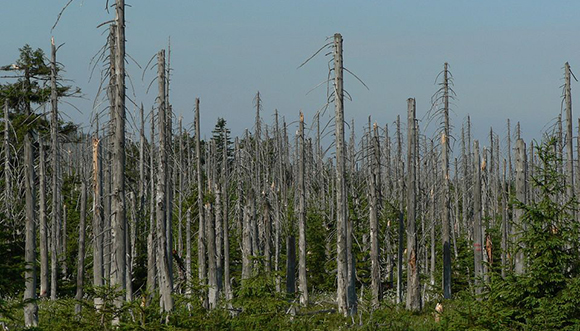For the time being, forests are helping to slow CO2 accumulation and climate change
A study led by CREAF shows that decreases in pollutant deposition and the increase in atmospheric CO2 have stimulated photosynthesis and carbon sequestration in forests. Therefore, it is crucial to understand how carbon circulates in the atmosphere, in living organisms, oceans, and soils in order to anticipate the effects of climate change.
The increasing concentration of atmospheric CO2 is the main cause of climate change and global warming – this is why it is important to understand the carbon cycle and what mechanisms modify its dynamics on Earth. A study published in the journal Nature Scientific Reportsby a number of CREAF researchers shows that the carbon cycle and its effects of climate change vary according to a complex network of interactions between the components of the atmosphere including gases, pollutants, human emissions, and other particles.
The research analyzed 23 forests in Europe and the United States and found that forests assimilated 1% more carbon each year between 1995 and 2011.
The article first assesses how CO2 from the atmosphere has interacted with forests. Plants absorb CO2 to grow by means of photosynthesis. If CO2 increases in the atmosphere, photosynthesis is more efficient because plants have more of it available, and therefore grow more, as when fertiliser is used. The research has analysed 23 forests in Europe and the United States and found that forests have fixed 1% more carbon every year from 1995 to 2011.

"We need to take into account all of the elements in the atmosphere and how they fluctuate within it. The flow and movement of carbon through ecosystems responds to a complex set of relationships that stimulate both carbon capture and emissions".
MARCOS FERNÁNDEZ-MARTÍNEZ, autor principal de l’estudi i investigador del CREAF i de la Universitat d’Anvers.
Because of this, over the last two decades forests have been been important allies in curbing climate change. It is estimated that they have sequestered an average of 30% of the CO2 emitted by humans. However, other studies warn that this fertilizing effect is losing its power. The rate of carbon capture in terrestrial ecosystems – CO2-saturated and limited by a lack of water and other nutrients such as sulfur and nitrogen – will continue to decrease, and some could even begin to release more carbon than they take in.
Over the last two decades forests have been been important allies in curbing climate change. It is estimated that they have sequestered an average of 30% of the CO2 emitted by humans.
The authors also note that forests are now more productive thanks to improvements in environmental policies which have slowed the deposition of sulfur and nitrogen from polluting gases. These two elements are the main culprits of acid rain, and with less episodes of acid rain forest health has improved. However, the study also demonstrates complex, intertwining relationships, and the fact that nitrogen inputs to these ecosystems has been reduced must also be taken into account. Nitrogen in some cases may have become a scarce nutrient, thereby reducing plant growth and thereby carbon capture.
“For this reason we need to take into account all of the elements in the atmosphere and how they fluctuate within it. The flow and movement of carbon through ecosystems responds to a complex set of relationships that stimulate both carbon capture and emissions,” says the lead author of the study, CREAF and University of Antwerp researcher Marcos Fernández Martínez. Marcos Fernández Martínez.

For the time being, climate change is not the greatest factor affecting the carbon balance
The study has also served to demonstrate that there are other factors – not only climate change – modifying the capacity of forests to emit and capture carbon. In all of the 23 forests studied, neither temperature nor water conditions – conditions directly linked to climate – changed significantly during the study period (between 10 and 19 years depending on the location). Therefore, “the carbon balance must have changed due to availability of nutrients, CO2, or the presence of contaminants as opposed to climate. But it is possible that in the future the effects of climate change, which are becoming more and more intense, could become of much greater importance in terms of effects on carbon balances on the global scale,” says the researcher.
Finally, the study highlights the need to obtain data from longer periods and from other regions of the Earth in order to see how the deposition of different elements and climate change affect carbon flows on a broad scale. “The trends will be different since developing countries are expected to increase the deposition of sulfur and nitrogen, as western countries had done until only a few decades ago”, says Marcos Fernández-Martínez.
REFERENCE ARTICLE
Fernández-Martínez M., Bartrons M., Sardans J., Verger A., Peñuelas J, et al.(2017). Atmospheric deposition, CO2, and change in the land carbon sink. Scientific Reports 7: 9632. DOI 10.1038/s41598-017-08755-8






